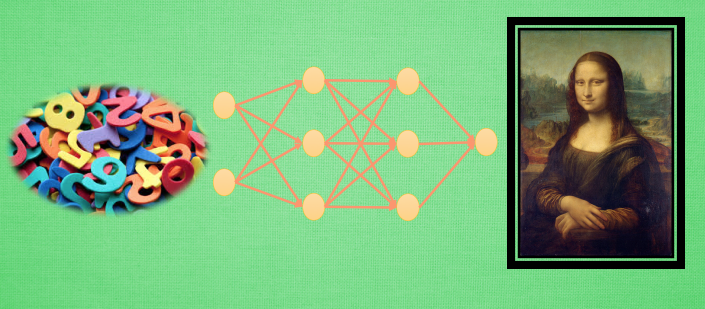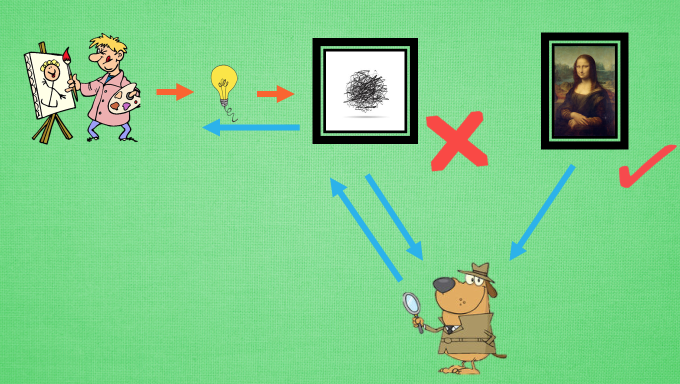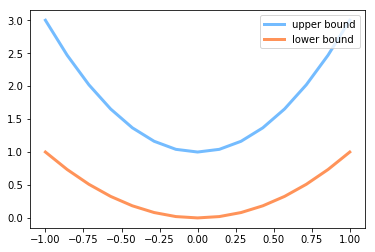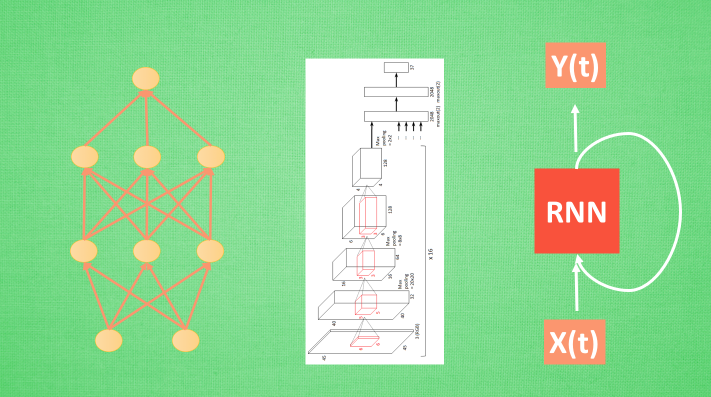深度學習(莫煩 神經網路 lecture 4) TensorFlow (GAN)
TensorFlow (GAN)
目錄
1、GAN
今天我們會來說說現在最流行的一種生成網路, 叫做 GAN, 又稱生成對抗網路, 也是 Generative Adversarial Nets 的簡稱
1.1 常見神經網路形式
神經網路分很多種, 有普通的前向傳播神經網路 , 有分析圖片的 CNN 卷積神經網路 , 有分析序列化資料, 比如語音的 RNN 迴圈神經網路 , 這些神經網路都是用來輸入資料, 得到想要的結果, 我們看中的是這些神經網路能很好的將資料與結果通過某種關係聯絡起來
1.2 生成網路
但是還有另外一種形式的神經網路, 他不是用來把資料對應上結果的, 而是用來”憑空”捏造結果, 這就是我們要說的生成網路啦. GAN 就是其中的一種形式. 那麼 GAN 是怎麼做到的呢? 當然這裡的”憑空”並不是什麼都沒有的空盒子, 而是一些隨機數.

對, 你沒聽錯, 我們就是用沒有意義的隨機數來生成有有意義的作品, 比如著名畫作. 當然, 這還不是全部, 這只是一個 GAN 的一部分而已, 這一部分的神經網路我們可以想象成是一個新手畫家.
1.3 新手畫家 & 新手鑑賞家
畫家作畫都需要點靈感 , 他們都是依照自己的靈感來完成作品. 有了靈感不一定有用, 因為他的作畫技術並沒有我們想象得好, 畫出來有可能是一團糟. 這可怎麼辦, 聰明的新手畫家找到了自己的一個正在學鑑賞的好朋友 – 新手鑑賞家.
可是新手鑑賞家也沒什麼能耐, 他也不知道如何鑑賞著名畫作 , 所以坐在電腦旁邊的你實在看不下去了, 拿起幾個標籤往螢幕上一甩 , 然後新手鑑賞家就被你這樣一次次的甩來甩去著甩乖了, 慢慢也學會了怎麼樣區分著名畫家的畫了. 重要的是, 新手鑑賞家和新手畫家是好朋友, 他們總愛分享學習到的東西.
所以新手鑑賞家告訴新手畫家, “你的畫實在太醜了, 你看看人家達芬奇, 你也學學它呀, 比如這裡要多加一點, 這裡要畫淡一點.” 就這樣, 新手鑑賞家將他從你這裡所學到的知識都分享給了新手畫家, 讓好朋友新手畫家也能越畫越像達芬奇. 這就是 GAN 的整套流程, 我們在來理一下.

新手畫家用隨機靈感畫畫 , 新手鑑賞家會接收一些畫作, 但是他不知道這是新手畫家畫的還是著名畫家畫的, 他說出他的判斷, 你來糾正他的判斷, 新手鑑賞家一邊學如何判斷, 一邊告訴新手畫家要怎麼畫才能畫得更像著名畫家, 新手畫家就能學習到如何從自己的靈感畫出更像著名畫家的畫了. GAN 也就這麼回事.
1.4 GAN網路

Generator 會根據隨機數來生成有意義的資料 , Discriminator 會學習如何判斷哪些是真實資料 , 哪些是生成資料, 然後將學習的經驗反向傳遞給 Generator, 讓 Generator 能根據隨機數生成更像真實資料的資料. 這樣訓練出來的 Generator 可以有很多用途, 比如最近有人就拿它來生成各種臥室的圖片.

甚至你還能玩點新花樣, 比如讓圖片來做加減法, 戴眼鏡的男人 減去 男人 加上 女人, 他居然能生成 戴眼鏡的女人的圖片. 甚至還能根據你隨便畫的幾筆草圖來生成可能是你需要的藍天白雲大草地圖片. 哈哈, 看起來機器也能有想象力啦
1.5 例子
import tensorflow as tf
import numpy as np
import matplotlib.pyplot as plt
tf.set_random_seed(1)
np.random.seed(1)
# Hyper Parameters
BATCH_SIZE = 64
LR_G = 0.0001 # learning rate for generator
LR_D = 0.0001 # learning rate for discriminator
N_IDEAS = 5 # think of this as number of ideas for generating an art work (Generator)
ART_COMPONENTS = 15 # it could be total point G can draw in the canvas
PAINT_POINTS = np.vstack([np.linspace(-1, 1, ART_COMPONENTS) for _ in range(BATCH_SIZE)])
# show our beautiful painting range
plt.plot(PAINT_POINTS[0], 2 * np.power(PAINT_POINTS[0], 2) + 1, c='#74BCFF', lw=3, label='upper bound')
plt.plot(PAINT_POINTS[0], 1 * np.power(PAINT_POINTS[0], 2) + 0, c='#FF9359', lw=3, label='lower bound')
plt.legend(loc='upper right')
plt.show()
def artist_works(): # painting from the famous artist (real target)
a = np.random.uniform(1, 2, size=BATCH_SIZE)[:, np.newaxis]
paintings = a * np.power(PAINT_POINTS, 2) + (a-1)
return paintings
with tf.variable_scope('Generator'):
G_in = tf.placeholder(tf.float32, [None, N_IDEAS]) # random ideas (could from normal distribution)
G_l1 = tf.layers.dense(G_in, 128, tf.nn.relu)
G_out = tf.layers.dense(G_l1, ART_COMPONENTS) # making a painting from these random ideas
with tf.variable_scope('Discriminator'):
real_art = tf.placeholder(tf.float32, [None, ART_COMPONENTS], name='real_in') # receive art work from the famous artist
D_l0 = tf.layers.dense(real_art, 128, tf.nn.relu, name='l')
prob_artist0 = tf.layers.dense(D_l0, 1, tf.nn.sigmoid, name='out') # probability that the art work is made by artist
# reuse layers for generator
D_l1 = tf.layers.dense(G_out, 128, tf.nn.relu, name='l', reuse=True) # receive art work from a newbie like G
prob_artist1 = tf.layers.dense(D_l1, 1, tf.nn.sigmoid, name='out', reuse=True) # probability that the art work is made by artist
D_loss = -tf.reduce_mean(tf.log(prob_artist0) + tf.log(1-prob_artist1))
G_loss = tf.reduce_mean(tf.log(1-prob_artist1))
train_D = tf.train.AdamOptimizer(LR_D).minimize(
D_loss, var_list=tf.get_collection(tf.GraphKeys.TRAINABLE_VARIABLES, scope='Discriminator'))
train_G = tf.train.AdamOptimizer(LR_G).minimize(
G_loss, var_list=tf.get_collection(tf.GraphKeys.TRAINABLE_VARIABLES, scope='Generator'))
sess = tf.Session()
sess.run(tf.global_variables_initializer())
plt.ion() # something about continuous plotting
for step in range(5000):
artist_paintings = artist_works() # real painting from artist
G_ideas = np.random.randn(BATCH_SIZE, N_IDEAS)
G_paintings, pa0, Dl = sess.run([G_out, prob_artist0, D_loss, train_D, train_G], # train and get results
{G_in: G_ideas, real_art: artist_paintings})[:3]
if step % 50 == 0: # plotting
plt.cla()
plt.plot(PAINT_POINTS[0], G_paintings[0], c='#4AD631', lw=3, label='Generated painting',)
plt.plot(PAINT_POINTS[0], 2 * np.power(PAINT_POINTS[0], 2) + 1, c='#74BCFF', lw=3, label='upper bound')
plt.plot(PAINT_POINTS[0], 1 * np.power(PAINT_POINTS[0], 2) + 0, c='#FF9359', lw=3, label='lower bound')
plt.text(-.5, 2.3, 'D accuracy=%.2f (0.5 for D to converge)' % pa0.mean(), fontdict={'size': 15})
plt.text(-.5, 2, 'D score= %.2f (-1.38 for G to converge)' % -Dl, fontdict={'size': 15})
plt.ylim((0, 3)); plt.legend(loc='upper right', fontsize=12); plt.draw(); plt.pause(0.01)
plt.ioff()
plt.show()


